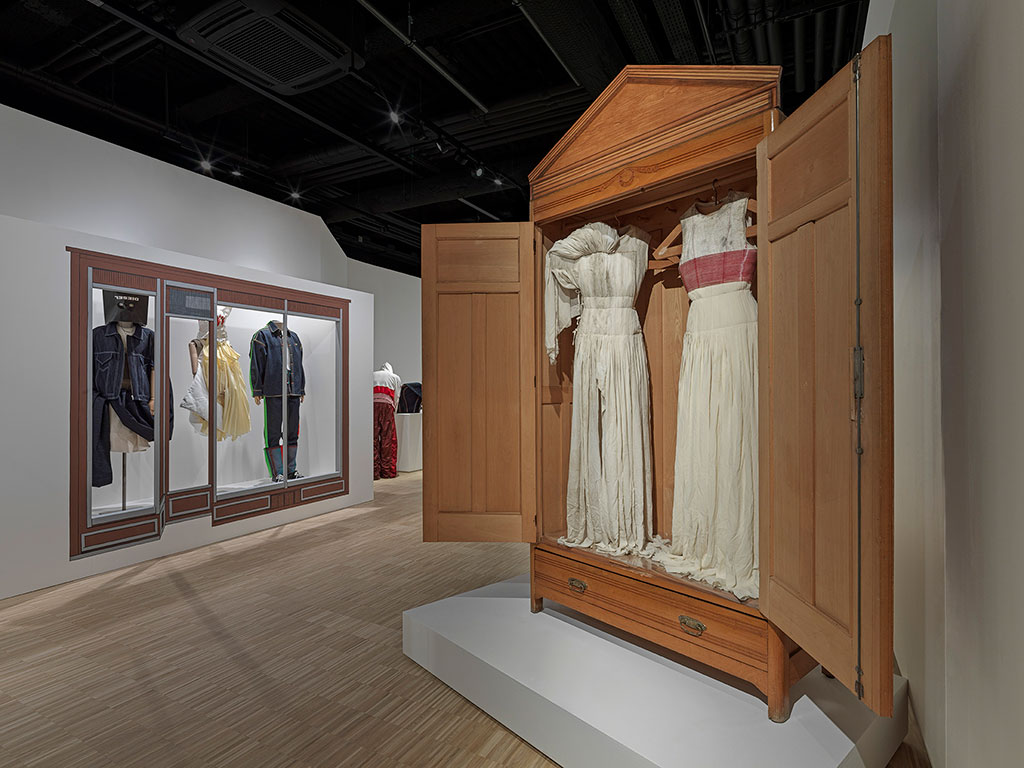
Dissecting Emanuele Coccia’s Curatorial Approach
“The Many Lives of a Garment” is not your typical fashion exhibition. It is designed to challenge and redefine your relationship with clothing and your perception of museums, introducing a new perspective on fashion and its display.
Philosopher and co-curator Emanuele Coccia was quite deliberate in his choice. Philosophers open doors to landscapes we did not know existed, stimulating our quest for knowledge by questioning our lack of it. They lead us to viewpoints that reveal new possibilities, whispering in our ears, “take a closer look,” and igniting the doubt that we might be missing something. This often leads us to live more enriched lives: I know, therefore I am.
A collaboration with esteemed fashion historian Olivier Saillard, who curated ITS Arcademy’s “The First Exhibition – 20 Years of Contemporary Fashion Evolution,” the premise of “The Many Lives of A Garment” is profoundly simple: exhibitions and museums can be anywhere. The context is irrelevant, as they surround us. Delving into Emanuele Coccia’s mindset reveals his unique perspective on fashion, exhibitions, and the museums that host them.
“An exhibition is an improvised enclosure that separates a place from the rest of reality, so that a miracle, in the literal, theological sense of the word, takes place within it. It creates a space-time where the usual order is suspended. For a moment, things align in different ways, creating a timeframe that defies the sequence of causes and effects,” he writes.
This realignment allows exhibitions to map “in the fabric of reality another order that forever changes the substance of the world.” By introducing this new perspective, Emanuele suggests that choice, a fundamental human act, makes us all curators of our worlds. “We cannot exist without choosing, selecting, and gathering what contains as much good as possible.” Our world never fully coincides with stark reality.
And again, “Every exhibition is the paradigm of cosmogony. What we call the world is never the complete and exhaustive list of what exists, it is not the totality of reality. (…) Every exhibition is evidence that we cannot get better without transforming the world, even if it is only a matter of recombining its order.”


Applying this knowledge to fashion, we see that fashion is our constant attempt to turn each of our lives into a unique world, a manifestation of the psychic into the material. Fashion translates our self-perception into the clothes we wear:
“We all wear clothes, regardless of class, gender, ethnicity, and geographical location. We wear them every day and throughout the day, even at night. A garment is an artifact that presupposes a dual use, both practical and contemplative. We do not merely contemplate it; we make it match our face, we make our body adhere to its body.”
We are, essentially, curators and artists of ourselves. Through fashion, we transform our bodies into living, travelling museums of our egos, microcosmic exhibitions traversing the world’s cities. With “The Many Lives of a Garment,” the very idea of a museum changes, no longer confined to the enclosures assigned by cities.

We are compelled to consider the possibility that there are as many museums as there are souls. “This exhibition moves from this assumption of a mutual resonance between museum and fashion, which has forever transformed the nature of clothes as well as that of museums,” writes Emanuele Coccia. “This idea inspired Olivier Saillard in his work as curator and director of museums (including the prestigious Musée Galliera in Paris), up to his more recent experiences relating to performance. This exhibition summarises and reviews all the museum experiments he has conducted in his long career,” he adds.
Olivier Saillard’s curatorial approach constantly shifts our focus from the fashion item to what lies beyond it, or perhaps more precisely, to what metaphysically inhabits it. Garments live the lives of their wearers, permeated by memories and emotions, bearing the marks of time like the bodies that carried them across the world. Microcosms travelling the cosmos, they represent us without our presence. Their preciousness lies beyond their appearance.

Writers and poets have long understood the power of clothing:
“Clothing is above all the faded memory of our being, the tired double of each of us. It has inspired the most beautiful pages in the history of literature. (…) The description of the dress is not necessarily less relevant than the real dress. On the contrary, it is as if the words represent a second body, a glorious body where fashion exists as a pure memory or premonition of happiness no longer measured by calendar time. In words, clothes become the glory of our life.”
In “The Many Lives of a Garment,” Emanuele Coccia and Olivier Saillard tell us, perhaps for the first time, that we are an integral part of the exhibition itself, “the walking, variable rooms of a spectacle that never cease to infect all bodies. (…) Because of fashion, it is impossible to reduce our lives to a single face, a single identity. By making every place and moment of a dress’s existence an alternative yet perfectly realized form of museum, this exhibition seeks to unfold, and at the same time accompany, this power of multiplication of the world and life that every garment, even the humblest, will never cease to have.”

For further reflections on fashion, museums, and their societal roles, visit “The Many Lives of a Garment,” and pick up a copy of the official catalogue. Written by Emanuele Coccia in conversation with Olivier Saillard, it explores what fashion means for the curators and what it could mean for you if you explore new perspectives.
ITS Arcademy – Museum of Art in Fashion
Via della Cassa di Risparmio 10, Trieste, Italy
Until January 6th, 2025.
Other articles:
The Seismographer
Your Kids, One Museum, and Lots of Fun – A family day out at ITS Arcademy is an experience not to be missed
18 October, 2024
We were all born to create, and it’s during childhood that this is most evident. Our favourite adult would place a blank sheet of paper in front of us along with…
The Seismographer
How to make a killer fashion portfolio.
7 rules you should follow to hit the mark.
12 September, 2024
Fashion portfolios speak a language of their own. Their architecture and content can be driven by cultural and social markers as diverse as the nations of our planet. The level of…
The Seismographer
The designers of the future are here – If you need a “push” to find reasons to apply, you’re welcome
02 September, 2024
“How to” – perhaps one of the most (if not THE most) asked question on the internet. How to do this, how to do that, how to build, how to make,…
The Seismographer
A Year in Fashion Conservation: Planned work for 2024 by the ITS Collection conservation team.
02 August, 2024
We have already dealt with the huge (and beautifully exciting) work that is the conservation of a unique collection like the one of ITS Arcademy – Museum of Art in Fashion,…